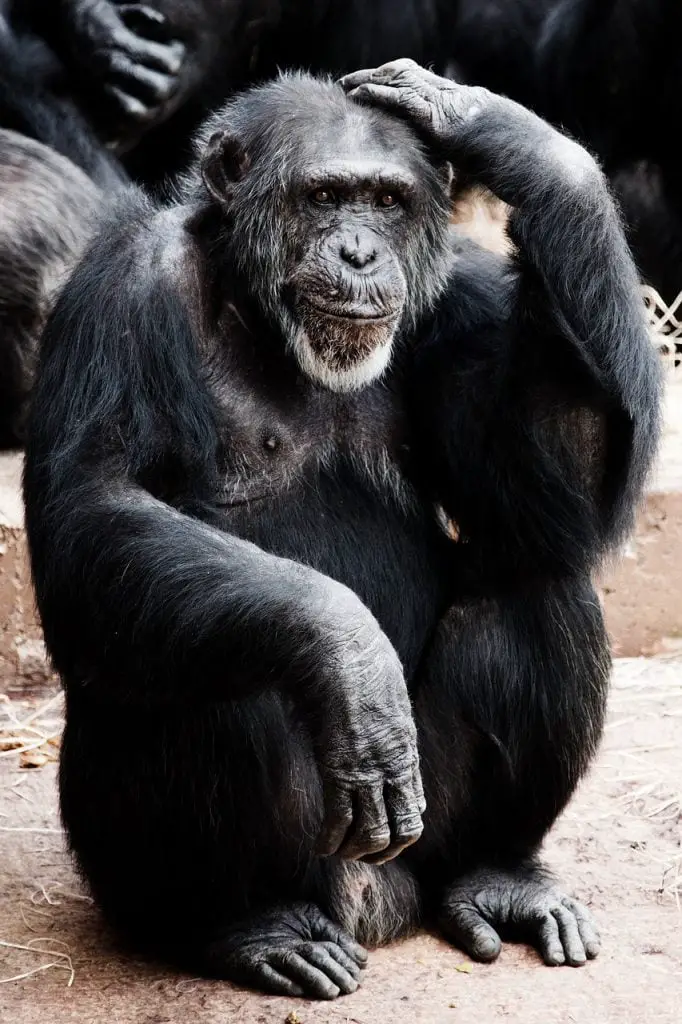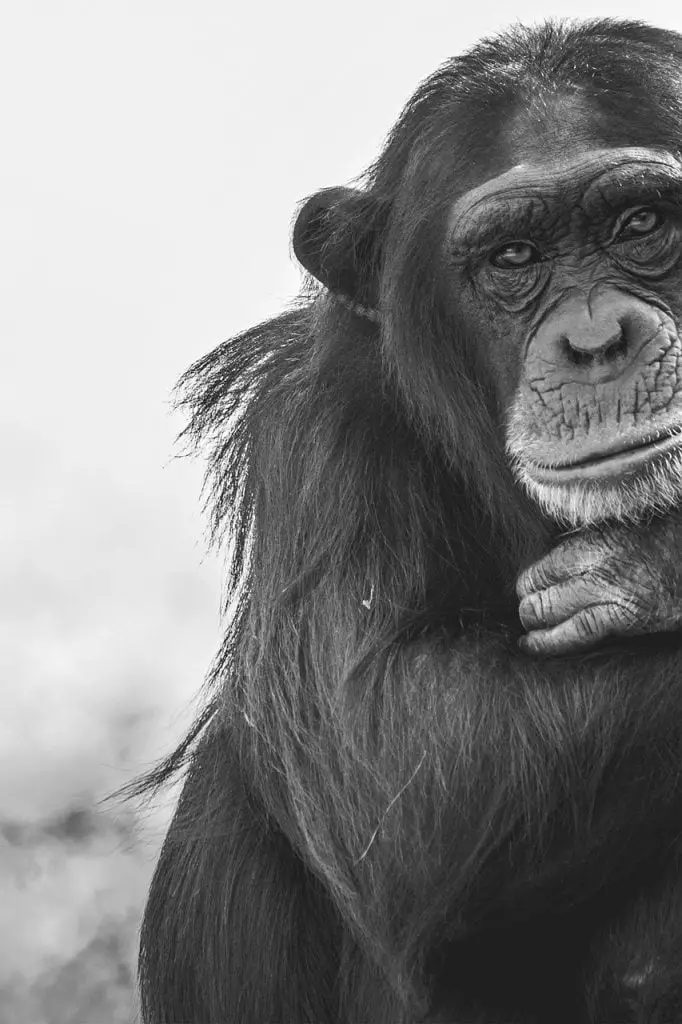Bondo apes, otherwise known as Bili Apes, have a mysterious scientific past. For several decades, many thought that Bondo Apes were merely a creature of legend. But after scientific fact-finding, it’s clear that Bondo apes are real. Today, I’ll share a comprehensive look at these fascinating primates.
Key Facts:
- Bondo apes, sometimes called mystery apes, orginailyl sparked speculation about a newfound primate species.
- But scientists have determined that Bondo apes are a subspecies of chimpanzees.
What Are Bondo Apes?

Bondo apes are a subspecies of chimpanzees, which makes their scientific name Pan troglodytes schweinfurthii.
When initially encountered by scientists, Bondo apes were treated as a potentially different species of primate. However, further research shows that these primates are acutally a subspecies of chimpanzees.
Where Do Bondo Apes Live?
Bondo apes live in the Democratic Republic of Congo. These Bili apes live deep in the forests of the area.
While the country has seen signficant strife in the last several decades, the warzone has started to penetrate the dense forset that Bondo apes call home. As humans on the run look for shelter and poachers march into the jungle, the once-impentreable forest that protected the apes for so long is starting to feel the impacts of humans.
History of Bondo Apes
Bondo apes were initally introduced to the scientific community in the 1990s. The intial discovery of a slightly different skull-type lead some to speculate that Bondo apes were an entirely different species. Not only were the animals considered a possibly different species but many also thought these creatures were a part of the legends of the lion killer apes.
As the debate swirled, a primatologist from the University of Amsterdram, Cleve Hicks, decided to track the species for a year to get to the bottom of the matter. Hicks and his team spent a year gathering foorage, collecting DNA, and observing the behaviors of these previously unstudied groups of primates.
Eventually, DNA evidence proved that these primates were a subspecies of chimp. However, the observations collected by the Hicks team showed that these chimpanzees were living in an entirely different way than other chimps of the world. A few examples includes using different types of sticks to collect different types of ants, smashing turtles open on rocks, and even eating a leopard carcass.
Plus, these specific chimps don’t appear to be shy. Hicks reported that the chimps approached the researchers to investigate the group. Even though these animals aren’t a unique species, the unique behaviors have made Bondo apes the subject of intense specualtion and scientific observation.
Bondo Apes: Facts
Let’s explore more about what makes bondo apes unique.
Physical Appearance

Bondo apes, also known as Bili apes, are visually striking creatures with distinct physical features. These great apes have a robust and muscular build, allowing them to navigate their arboreal habitat with ease. Their brown-black fur is dense and shaggy, providing protection against the elements.
One of the most notable characteristics of bondo apes is their prominent cheek pads. These facial flanges are present in adult males and serve as a display of dominance within their social groups. The size and development of these cheek pads vary among individuals, with older and more dominant males exhibiting larger and more pronounced flanges.
In addition to their facial flanges, bondo apes possess other facial features that make them instantly recognizable. Their broad and elongated faces are adorned with a prominent nose and large, expressive eyes. These features, combined with their distinctive fur coloration, give bondo apes a unique and captivating appearance.
Size
Adult male bondo apes can reach an impressive height of up to 5 feet (1.7 meters) when standing upright. They possess a robust build. In comparison, adult female bondo apes are slightly smaller, standing at an average height of around 4 to 4.5 feet (1.2 to 1.4 meters) and weighing approximately 150 to 200 pounds (68 to 91 kilograms). Despite their smaller stature, female bondo apes exhibit great strength and agility in their movements.
It’s important to note that the size of bondo apes can vary between individuals and populations. Factors such as nutrition, genetics, and environmental conditions can influence their growth and overall size. Nevertheless, these great apes remain formidable creatures, commanding respect with their impressive size and physical presence.
Habitat
Bondo apes inhabit the lush and dense rainforests of Central Africa, in the Democratic Republic of Congo. These magnificent creatures are primarily found in the lowland and montane forests, where they have adapted to thrive in their unique habitat.
The rainforests provide an ideal environment for bondo apes, offering ample food resources and protective coverage. These great apes are highly arboreal, spending the majority of their lives in the forest canopy. Their strong limbs and dexterous hands enable them to move effortlessly through the treetops, swinging from branch to branch in search of fruits, leaves, and other vegetation.
Notably, this population of chimpanzees sometimes chooses to nest on the ground. The chimps tend to make their nests lower to the ground as the forest density increases. But when closer to the presence of humans, the chimps choose to make their nests higher in the trees. This trend is possibly designed to keep themselves safe from the unwelcome presence of humans.
The bondo apes’ habitat is characterized by a complex and layered ecosystem. The dense vegetation provides shelter and concealment, allowing these apes to establish their nests and rest in the safety of the forest canopy. The rich biodiversity of the rainforest also provides a diverse array of food sources, contributing to the survival and sustenance of the bondo apes.
Social Structure
Based on the data collected by Hicks and his team, it’s likely that Bili apes adhere to a fission-fusion social system.
A fission-fusion social system is characterized by dynamic and ever-changing group compositions. In this system, chimpanzees form large communities that can split into smaller subgroups and later merge again, resulting in a fluid and flexible social structure.
Within a chimpanzee community, individuals may associate closely in smaller groups called parties. These parties consist of varying numbers of individuals and can form for different purposes such as foraging, socializing, or engaging in specific activities. The composition of these parties can change frequently, with chimpanzees joining and leaving different groups based on their social relationships, reproductive strategies, or resource availability.
The fission-fusion social system in chimpanzees offers several advantages. It allows individuals to maximize their social connections, engage in cooperative behaviors, and minimize competition for resources within the larger community. It also provides opportunities for information sharing, learning, and the development of social bonds among individuals.
Behavior
One notable behavior is their remarkable tool usage. Bili apes have been observed fashioning tools from branches or leaves to extract insects or honey from crevices. This behavior showcases their problem-solving abilities and resourcefulness in obtaining food.
An elaborate communication system is a hallmark of these creatures. They utilize a combination of vocalizations, facial expressions, and gestures to convey messages and maintain social bonds within their family groups. From chest-beating displays to soft vocalizations, these apes engage in complex communication to express emotions, establish dominance, and coordinate group activities.
Bondo apes also demonstrate a strong sense of social bonding. They engage in grooming sessions, which not only help maintain hygiene but also serve as a means of establishing and strengthening social connections within their family groups. Through grooming, they reinforce social bonds, reduce tension, and exhibit cooperation among individuals.
Furthermore, bondo apes exhibit territorial behaviors to defend their home ranges. They mark their territories with vocalizations, scent marking, and physical displays to communicate ownership and deter potential intruders. These territorial behaviors help maintain group cohesion and protect vital resources within their habitat.
Reproduction
Bondo apes have a polygynous mating system, where dominant silverbacks mate with multiple females within their troop. The alpha male establishes a harem of females, known as bondo queens, who are exclusively associated with him for mating. This mating strategy allows the male to maximize his reproductive success by ensuring that his genes are passed on to future generations.
Their reproductive cycle follows a pattern similar to other great apes. Females experience estrus, a fertile period, during which they exhibit physical and behavioral cues signaling their readiness to mate. This timing often aligns with the female’s ovulation, increasing the chances of successful fertilization.
Parental care is another crucial aspect of the reproductive tendencies of Bili apes. After a gestation period of about eight months, the female gives birth to a single offspring. The bondo queens invest significant effort in nurturing and raising their young. The male also plays a role in protecting and ensuring the safety of the offspring within the troop.
Wild Facts about Bondo Apes
Here are some wild facts about these interesting primates:
- Legendary lion killers: The Bondo apes are surrounded by legends of killing lions. But it’s unlikely these legends are rooted in truth.
- Tool usage streamlined their lives: These unique chimpanzees use a range of tools, including sticks and rocks, to make their foraging easier.
Conservation Status of Bili Apes
Bili apes face a range of significant threats that endanger their population and habitat. Deforestation poses a severe risk as vast areas of their rainforest home are cleared for agriculture, logging, and human settlements. This habitat loss disrupts the delicate balance of their ecosystem, fragmenting their habitat and limiting their access to food sources and safe territories.
Illegal hunting and poaching are also major threats to Bili apes. Despite legal protections, these intelligent creatures are targeted for their meat, body parts, and the illegal pet trade. The demand for bushmeat and the exotic pet market drive the illicit activities that further diminish their already vulnerable population.
The encroachment of human activities into bondo ape habitats brings additional challenges. Increased human-wildlife conflict arises as competition for resources intensifies. The expansion of infrastructure and the presence of humans in close proximity to their habitats lead to increased disturbance, stress, and the potential spread of diseases to these fragile populations.
Climate change adds another layer of threat to bondo apes. Rising temperatures, altered rainfall patterns, and other climatic shifts can impact the availability of food and water sources, further straining their survival. Changes in their environment can also disrupt their reproductive patterns and overall population dynamics.
Frequently Asked Questions
You have questions about Bondo apes. I have answers.
How big is a Bondo ape?
Bondo apes can grow up to 5 feet tall.
Why are Bondo apes so special?
Bondo apes were once called the mystery apes. Legends and scientific uncertainity fueled speculation about these primates. Eventually, DNA evidence determined that Bili apes are a subspecies of chimpanzees.
What is the largest chimp on record?
The largest chimpanzee that ever lived, Giganthopithecus blacki, went exticnt around 300,000 years ago. The remaining tooth samples indicate that these primates were larger than currently-living gorillas.
Final Take on Bondo Apes
While the mysterious origins of Bili apes have been settled, these primates are still fasincating creatures that deserve the attention they receive. Further research on these animals is necessary to fully understand their social structure and habits.
